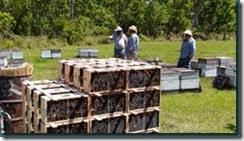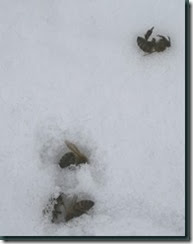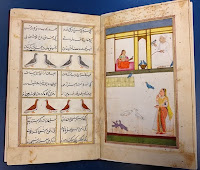NYT Review of Sachal Jazz Ensemble at the Lincoln Center
Mr. Marsalis is tireless, and very effective, in explaining the connections between different kinds of music around the world. In this concert he leaned hard on the idea of the habanera rhythm — common in one way or another in African, Antillean and new-world popular music — being one of those affinities. And so the two ensembles piled in on Morton’s “New Orleans Blues,” arranged by Victor Goines, of the Jazz at Lincoln Center Orchestra, and they figured out a way to build the habanera rhythm together.
The Pakistani musicians, on the left, played on the beat with precision and intent; the Americans, on the right, played behind it. But there was enough flexibility and amassed sound to approximate something like the rolling feeling of swing.
One of the ways to use your ears in Saturday night’s concert was to notice when and how well each side bent toward the other. The orchestra’s drummer, Ali Jackson, getting light and quiet on his instrument and listening hard, was all-important to the process. But so was the Pakistani flutist Baqar Abbas, the Sachal Jazz Ensemble’s clearest and most house-wrecking virtuoso, who bent and warped notes as an absolute matter of course rather than for effect. In one of the concert’s best stretches, he traded solos with Ted Nash, from the orchestra, playing piccolo.
They got around to “Take Five,” a song with another linking agent — its five-beat rhythm cycle, fairly common in Carnatic and Hindustani music. In a solo, the sitarist Indrajit Roy-Chowdhury stretched out in his own technique in a more jazzlike melodic improvisation. The technique was exact and contained, the tempo stately enough that every note could be heard.
And once again, here is the video of their fantastic version of Take Five:
And if you want to move in the direction of R.E.M, here is Sachal Studios' take on Everybody Hurts (here is the original):
The Tree of Faith PDF
The Tree of Faith

BECOME ACQUAINTED WITH ISLAM
LESSON 145: 7 Ways To Check On Your Hive During Winter www.honeybeesonline.com 217-427-2678
Happy Thanksgiving everyone! Today is known as Black Friday, the day after thanksgiving when everyone rushes the stores in hopes of getting the best deals on Christmas gift purchases. Not me! We’re enjoying these couple of days off, putting up our Christmas tree and eating too much. I never did get into Black Friday. I used to wait and buy gifts a few days before Christmas. For the last few years, online shopping has taken the stress out of gift shopping for me. I research what I need online, purchase it online and soon it is delivered to my home. Awesome! I save gas, time and a lot of frustration.
 Here at Long Lane Honey Bee Farms, we’ve made it even more easier for you to shop online at our store with our new mobile website. Log in to www.honeybeesonline.com from your smart phone and you’ll see our new smart phone website, making your shopping experience much more enjoyable.
Here at Long Lane Honey Bee Farms, we’ve made it even more easier for you to shop online at our store with our new mobile website. Log in to www.honeybeesonline.com from your smart phone and you’ll see our new smart phone website, making your shopping experience much more enjoyable.
 PACKAGES OF BEES NOW ON SALE & THEY ARE SELLING FAST
PACKAGES OF BEES NOW ON SALE & THEY ARE SELLING FAST
We are selling PICK UP ONLY packages of 3lbs of bees with a mated queen again this year. CLICK HERE to secure your packages for late April of 2014. WARNING: They are selling faster than we’ve ever seen. Do not delay.
2014 Beekeeping Classes
 Sheri and I sat down and worked out all the details for our 2014 Beekeeping Classes including our second week long Beekeeping Institute. Sheri, being a teach by trade, has designed student workbooks for all our classes. We’ll be using more hands on in our classes to help the learning experience really click. This year we are also adding a slew of FREE Introductory Meetings:
Sheri and I sat down and worked out all the details for our 2014 Beekeeping Classes including our second week long Beekeeping Institute. Sheri, being a teach by trade, has designed student workbooks for all our classes. We’ll be using more hands on in our classes to help the learning experience really click. This year we are also adding a slew of FREE Introductory Meetings:
FREE 2013 Dec 13th. INFORMATIONAL MEETING
FREE 2013 Dec 19th. INFORMATIONAL MEETING
FREE 2014 Jan 4th. INFORMATIONAL MEETING
FREE 2014 Jan 8th. INFORMATIONAL MEETING
FREE 2014 Jan 17th. INFORMATIONAL MEETING
These are free informational meetings on beekeeping. Are you curious about the hobby of beekeeping. Are you unsure of the cost and the time involved? Do you just need a little more information before you plunge in? Then come to one of our FREE informational meetings. Sign up is required. Click on one of the links above.
Here’s our class line up for 2014:
June 9-13 Beekeeping Institute
June 27-28 Queen Rearing Course
We are really excited that some of our classes have a new two day format starting with a Friday night dinner buffet at 6pm and then the workshop continues on until 9 p.m. This is a two day beginning beekeeping course and continues on Sat. 9-noon. Please book your classes above as soon as you can as they do fill up fast. Remember, our classes are limited and each seat sells out, so anyone attending must purchase a seat. Thank you and we look forward to another exciting year of learning more about bees.
Today, I want to share 7 ways to keep an eye on your hive now that it’s cold outside. Before I do, let me take a moment to encourage our new beginners with:
BEGINNER’S SPOTLIGHT
 Thinking about starting with bees in the spring. CAUTION: PLAN NOW!! Too many prospective beekeepers wait and try to order hives and bees in the spring only to find everything across the country is sold out. Do not delay. Order your bees now even though you will not get them until the spring. And order your hive equipment now too. We ship hives (without bees) now, but hives are in such demand in late winter and early spring that there usually is longer shipping delays. Don’t put it off or you may miss another year. Check our our most popular item our FREEDOM KIT, 2 complete hives. Click Here. FREEDOM KIT.
Thinking about starting with bees in the spring. CAUTION: PLAN NOW!! Too many prospective beekeepers wait and try to order hives and bees in the spring only to find everything across the country is sold out. Do not delay. Order your bees now even though you will not get them until the spring. And order your hive equipment now too. We ship hives (without bees) now, but hives are in such demand in late winter and early spring that there usually is longer shipping delays. Don’t put it off or you may miss another year. Check our our most popular item our FREEDOM KIT, 2 complete hives. Click Here. FREEDOM KIT.
Also, follow our daily updates on Facebook at: https://www.facebook.com/longlanehoney
LESSON 145: 7 Ways To Check On Your Hive During The Winter
We worry about our hives in the winter, don’t we? Are they cold? Are they diseased? Will they survive? Is my queen alive? We want to do something to help them along. While there is very little we can do at this point to help our bees, it does make us feel better to be actively checking on our hives during the winter.
1. PROVIDE FOOD
An average size colony has the same nutritional needs of a medium size dog. Bees need protein and carbohydrates just like us, just like most animals. Do your bees have enough honey (carbohydrates) and pollen (protein)? Bees consume their food in the winter to stay warm. Ideally, if the temperature stays around 30-40 degrees (f) they consume the least amount of food. But the colder it gets the more food they consume to generate heat.
 Our Winter-Bee-Kinds provide both carbohydrates and protein for your bees and provides upper vent/exit and 1” of upper insulation to help reduce excessive condensation. Many of you have been purchasing pollen patties from us and I’m glad to see that. While it is not as necessary with the use of the Winter-Bee-Kind, it is necessary if you are just wanting to provide extra protein. Bees cannot exist on sugar alone.
Our Winter-Bee-Kinds provide both carbohydrates and protein for your bees and provides upper vent/exit and 1” of upper insulation to help reduce excessive condensation. Many of you have been purchasing pollen patties from us and I’m glad to see that. While it is not as necessary with the use of the Winter-Bee-Kind, it is necessary if you are just wanting to provide extra protein. Bees cannot exist on sugar alone.
 Remember you cannot lift frames out of the hive when temperatures are below 60 degrees (f). If you do, you can damage developing pupa of bees. But you can lift the top off briefly to take a 30 second peak at food supplies by looking down between the frames of comb. Keep food on top of the winter cluster all winter long. This does not guarantee that your bees will make it, but at least they will not die from starvation.
Remember you cannot lift frames out of the hive when temperatures are below 60 degrees (f). If you do, you can damage developing pupa of bees. But you can lift the top off briefly to take a 30 second peak at food supplies by looking down between the frames of comb. Keep food on top of the winter cluster all winter long. This does not guarantee that your bees will make it, but at least they will not die from starvation.
2. WIND BLOCK
 Some studies have shown a slight advantage to wrapping a hive with roofing paper. Instead, I like the idea of a wind block. If you wrap your hive you’ll also need to provide more upper ventilation to reduce excessive condensation that causes cold water to drip on the colonies. With a wind bock, the fierce winter winds hitting the hive is reduced. Be careful. Do not place stray or hay bails next to the hive. They can hold water and this can provide too much moisture around the hive. Keep your wind block several feet back from the hive to help the area around the hive remain as dry as possible. You may have a natural wind block such as a grove of trees as in the photo or a shed. This works great.
Some studies have shown a slight advantage to wrapping a hive with roofing paper. Instead, I like the idea of a wind block. If you wrap your hive you’ll also need to provide more upper ventilation to reduce excessive condensation that causes cold water to drip on the colonies. With a wind bock, the fierce winter winds hitting the hive is reduced. Be careful. Do not place stray or hay bails next to the hive. They can hold water and this can provide too much moisture around the hive. Keep your wind block several feet back from the hive to help the area around the hive remain as dry as possible. You may have a natural wind block such as a grove of trees as in the photo or a shed. This works great.
3. STABILITY
 Make sure your hive is stable on its stand throughout the winter. As the ground freezes and thaws, your stand or blocks can shift and your hive may topple over. Also, if you broke the propolis seal on your top cover, a harsh winter storm could blow the top off. Regularly check your hive for any shifting and keep it stable all winter. Keep a rock or weight on top to help stabilize the hive.
Make sure your hive is stable on its stand throughout the winter. As the ground freezes and thaws, your stand or blocks can shift and your hive may topple over. Also, if you broke the propolis seal on your top cover, a harsh winter storm could blow the top off. Regularly check your hive for any shifting and keep it stable all winter. Keep a rock or weight on top to help stabilize the hive.
4. KEEP MICE OUT
 Mice will kill your hive if they nest over the winter in your hive. Take a flashlight when it’s dark, remove your entrance reducer or mouse guard and make sure you cannot see a mouse nest on your bottom board. If you see a pile of grass in a corner there is a mouse in your hive. If there is, find a friend to help you lift off the hive from the bottom board and if you are lucky the mice will stay in their nest on the exposed bottom board and you can get rid of them and put the hive back down on the bottom board and reduce the entrance. When you do this, please remember to keep your tops on and your deeps together. Do not open or separate your hive during the winter. Just lift it off the bottom board and check for mice. It’s better to find mice now than in April after they have destroyed your bees.
Mice will kill your hive if they nest over the winter in your hive. Take a flashlight when it’s dark, remove your entrance reducer or mouse guard and make sure you cannot see a mouse nest on your bottom board. If you see a pile of grass in a corner there is a mouse in your hive. If there is, find a friend to help you lift off the hive from the bottom board and if you are lucky the mice will stay in their nest on the exposed bottom board and you can get rid of them and put the hive back down on the bottom board and reduce the entrance. When you do this, please remember to keep your tops on and your deeps together. Do not open or separate your hive during the winter. Just lift it off the bottom board and check for mice. It’s better to find mice now than in April after they have destroyed your bees.
5. KEEP AN EYE OUT FOR CRACKS
If your equipment is old and falling to pieces, you might find corners missing and large cracks. Duct tape or metal tape can seal the gaps until you can replace your equipment in the spring. Broken bottom boards can allow mice to get in, so keep an eye out for drafty cracks.
6. PUT YOUR EAR ON THE HIVE AND TAP
You can put your ear on the side of your hive and tap and you may hear an increased buzzing. This serves no purpose other than bringing you false securing that all is okay. I have tapped on my hives and have heard absolutely nothing. But in the spring that same hive was doing great. There is some benefit. If you are sure that there is no sound of life in your hive, you can open it and verify by looking for 30 seconds between the comb. If the colony has perished it is best to shake out the dead cluster as soon as you can to prevent further decay inside on the combs. Just remember if you don’t hear anything it may speak more to your hearing than of your bees. Be careful as bees sting in the winter too.
7. KEEP THE ENTRACE CLEARED
 Snow and ice can pile up on the hive blocking the entrance at the bottom. In the past, I’d always go out after it snowed and especially after an ice storm and clear out the opening at the bottom of the hive. However, with our Winter-Bee-Kinds, the entrance is built into this feeding system and bees prefer a top entrance/exit during winter. This can allow your bees to take that much needed cleansing flight to potty which they may not have taken if they had to walk all the way to the bottom to fly out. Also, bees die of natural causes all winter and begin to accumulate on the bottom board, blocking the entrance. The upper entrance on the Winter-Bee-Kind keeps the bees away from the gross accumulation of dead bees below.
Snow and ice can pile up on the hive blocking the entrance at the bottom. In the past, I’d always go out after it snowed and especially after an ice storm and clear out the opening at the bottom of the hive. However, with our Winter-Bee-Kinds, the entrance is built into this feeding system and bees prefer a top entrance/exit during winter. This can allow your bees to take that much needed cleansing flight to potty which they may not have taken if they had to walk all the way to the bottom to fly out. Also, bees die of natural causes all winter and begin to accumulate on the bottom board, blocking the entrance. The upper entrance on the Winter-Bee-Kind keeps the bees away from the gross accumulation of dead bees below.
Keep an eye out on your hive this winter. Thanks for joining us for another beekeeping lesson. Hope to see you soon at one of our FREE Introductory meetings or at a class.
David and Sheri Burns
Long Lane Honey Bee Farms
www.honeybeesonline.com
217-427-2678
https://www.facebook.com/longlanehoney
Burka Avenger Beyond the Burqa
The super-hero animated series, Burka Avenger, was broadly covered in the press when its first episode aired in Pakistan back in August. The creators of the show argue that the burka superhero would empower young women by serving as a role model. Furthermore, one of the main goals of the show is to emphasize education for women - especially young girls. The first episode had the shades of Malala versus the Taliban.
 So how successful has the show been in achieving its goals beyond publicity and the selling of show-related merchandize (while I haven't yet found any follow-up episodes, I know I can shell out $20 for aBurka Avenger t-shirt - something that I doubt most women in Pakistan would be wearing)?
So how successful has the show been in achieving its goals beyond publicity and the selling of show-related merchandize (while I haven't yet found any follow-up episodes, I know I can shell out $20 for aBurka Avenger t-shirt - something that I doubt most women in Pakistan would be wearing)?I don't know the answer, but I think it would be an interesting project to see the show's impact, if any. Here are two articles that talk about two different aspects of the show: education and the use of burka as a costume.
Here is Hani Yusuf in Valerie magazine talking about Burka Avenger's goal of spreading education:
While Burka Avenger may be a valuable addition to local television entertainment, it is far from an effective education awareness program. With its lack of understanding of the nuances and complexities of regional politics, culture and economics, it falls short of reaching its target audience in Pakistan.And here is Daniel Martin Varisco at Tabsir on the use of burka as a super heroine costume:
Burka Avenger aims to raise education awareness in a country where half the population is illiterate and over a quarter lives below the poverty line. According to the media brochure, the TV show offers “positive social messages and morals.”
But Urban Pakistanis who speak Urdu and English are often those who already have access to formal education. And, English is only really spoken by a small fraction of Pakistanis who can afford private schools.
Government schools in Pakistan suffer from various budgetary and infrastructural problems. The current government’s spending on education is an abysmal 2 percent of its total spending.
So any effective education awareness campaign must target parents and government officials as well and must be region-specific, as the country’s micro regions have very different economic, cultural and social concerns.
Instead, Burka Avenger targets its education awareness campaign at children, but it is only able to reach children in urban centers.
At first glance this seems like a sound idea, importing a Western theme and inserting a Muslim character. There are quite a few video games that do this for men. But does it really work? As I watched the online first episode, it seemed like the Burqa Avenger was more like a Halloween witch, flying without the broom but decked out in black, than anything else. It may work as comedy, but I doubt this really empowers women who choose to wear a burqa. If the point is to show that there are tough Muslim women, would it not make more sense to show some real life examples? The make-believe aspect of the Burqa Avenger suggests that it could not happen in real life, like the Kuwaiti women in the wake of Saddam’s invasion back in 1990. The veiled cartoon heroine works as fantasy, but this only serves to reinforce the stereotype that there is a disconnect between the Islamic rhetoric about the value of women and the cultural practices that sometimes do not allow women any choice.
The commercial interest of the site is quite evident. The marketing is clearly for young people who like hip hop, as can be seen in the music videos, which are in English… So here is an in-your-face dj-type saying “Don’t mess with the lady in black, when she is on the attack.” I kind of doubt this will empower young Pakistani girls, but it may scare the hell out of young Pakistani males.I think both Hani and Daniel have raised excellent issues with the show, and I share these concerns (and as mentioned above, find marketing campaign quite over-the-top). However, I do not want to dismiss its impact out of hand. Popular culture, after all, has a long reach and carries weight in both urban and rural areas of Pakistan. I think some of that will have to depend on the quality of story-telling as well - especially if the writers can move beyond "message" stories to tales that resonate with deeper human connections (I guess, I'm wishing for a more literary Burka Avenger…). Based on the one episode we've had, the prospects are not that great on this account - but then Marvel and DC Comics have also crossed many cultural boundaries to have become a global phenomena.
But the question of impact is an empirical one. I think it will be a neat (and useful) comparative project to do focus-groups and/or individual interviews with women and men of the intended target age-group across different areas of Pakistan (there is a huge variation within urban centers as well, and I would throw in diasporic Pakistani community as well) to see how they view Burka Avenger and its goal of empowering and educating women with this female superhero.
RSOP Short Film Competition
Here is an announcement from Rationalist Society of Pakistan (RSOP) about a short film competition. And there is no cost to submit an entry:
RSOP is organizing a film competition, which is now open for submissions!The competition is open to UK and Pakistani Residents. You can see the other guidelines here.
This is a great opportunity to share your work on following topics!
- Forced Marriages
- Faith Healers
- Secularism: Dispelling Misconceptions
- Moon Sighting or Moon Fighting: Muslims at loggerheads every year
- Evolution: An Idiot’s guide to evolution
- Integration: The way forward Entry is free.
The closing date for entry is 10th of January, 2014. Films should be no longer than 10 minutes and can be shot on any equipment including DSLRs, iPhones and video cameras.
Permission must be sought from organisations/owners of buildings before filming in them and from all individuals shown in the film.
Copyright permission must be agreed before using any stock video, images or music.
Read more at: RSOP Short Film Competition | Rationalist Pakistan: Rationalist Society of Pakistan | http://www.rationalistpakistan.com/rsopfilmcompetition/RSOP is organizing a film competition, which is now open for submissions! This is a great opportunity to share your work on following topics! Forced Marriages Faith Healers Secularism: Dispelling Misconceptions Moon Sighting or Moon Fighting: Muslims at loggerheads every year Evolution: An Idiot’s guide to evolution Integration: The way forward Entry is free. The closing date for entry is 10th of January, 2014 Films should be no longer than 10 minutes and can be shot on any equipment including DSLRs, iPhones and video cameras. Permission must be sought from organisations/owners of buildings before filming in them and from all individuals shown in the film. Copyright permission must be agreed before using any stock video, images or music. Terms & Conditions The competition is open to UK and Pakistani Residents. All entries must be the original work of the entrant and must not infringe the rights of any other party. The working Languages should be English and/or Urdu. The entrants must be the sole owner of copyright in all videos/short films entered and must have obtained permission of any people featured in the entry or parents/guardians if children are less than 16 years. Entrants must not have breached any laws when filming. The films will be property of RSOP who will retain the right of using them in whatever way they deem suitable . Entrants can submit as many short films/videos as they wish. The videos may be uploaded on Vimeo and the link will be sent to editor@rationalistpakistan.com with subject “Short Film Competition Submission” to be specifically mentioned. The competition closes at Midnight (GMT), 10th of January, 2014. Winners will be announced on 20th of January, 2014. The winner of top three videos among all topics will be awarded honorary prizes of amount 100 UK Pounds for first three positions. The winners will be announced on the website. For any queries undersigned can be contacted on the mentioned email. Editor Rationalist Society of Pakistan editor@rationalistpakistan.com www.rationalistpakistan.com
Read more at: RSOP Short Film Competition | Rationalist Pakistan: Rationalist Society of Pakistan | http://www.rationalistpakistan.com/rsopfilmcompetition/
Mughals, pigeons and Darwin
We didn't have pigeons when I was growing up in Pakistan. But I remember (granted that it is a somewhat foggy memory) that some of my relatives did have "pet" pigeons on the roof of their house. The use of carrier pigeons is also mentioned in numerous stories in Urdu literature. And totally unrelated to Pakistan, I also enjoyed Jim Jarmusch's brilliant film, Ghost Dog: The Way of the Samurai, where a mafia hit man (played by Forrest Whitaker) communicated with the mafia mostly via carrier pigeons (oh - and he lived his life following his interpretation of the code of the Samurai. But I digress). Well, here is a fascinating Asian and African Studies blog post about the Moghul obsession with pigeon keeping:
In the Āʼīn-i Akbarī (‘Akbar’s regulations’), Abu’l-Fazl devotes a whole section (Book 2, Āʼīn 29) to amusements which include pigeon-flying (ʻishqbāzī), breeding and the different colours of the royal pigeons. Altogether there were estimated to be more than 20,000 pigeons at Akbar’s court, but only 500 were select (khāṣṣah). When the emperor moved camp, the pigeons were taken as well, with bearers carring their portable dovecotes. Pigeons were trained to do quite complicated manoevres: the wheel (charkh) “a lusty movement ending with the pigeon throwing itself over in a full circle” and turning somersaults (bāzī). A select pigeon could perform 15 charkhs and 70 bazis in one session. Although ordinary people were amused by pigeon flying, His Majesty, Abu’l-Fazl writes, “uses the occupation as a way of reducing unsettled, worldly-minded men to obedience, and avails himself of it as a means productive of harmony and friendship.”And not just that, you also have a book of poems dedicated to pigeons (kabutar in Persian and also in Urdu):
One of the most visually attractive items in the exhibition ‘Mughal India’ is ‘The book of pigeons’ (kabūtarnāmah) by Sayyid Muḥammad Mūsavī whose poetical name was Vālih. This work consists of a poem of 163 couplets, followed by a short prose treatise explaining the different types of pigeons, their colours and characteristics, and the art of pigeon-flying. It was written, as a gesture of friendship, for one Miyān Khūban who asked for an elegantly written account of pigeon flying.Darwin knew about these pigeons and sought information about them:
Charles Darwin (1809-82) was himself a keen pigeon fancier and set up a breeding loft at his home in the village of Downe, Kent. In the course of his research he corresponded with Sir Walter Elliot (1803-1887) a naturalist and ethnologist working in the Madras Civil Service. Darwin knew about Abu’l-Fazl’s chapter on pigeons (see Darwin and Elliot’s correspondence 1856-59): "I should mention that I have heard that such exist in the Ayin Akbaree in Persian (I know not whether I have spelt this right) but as this work is translated I can consult it in the India House [i.e. India Office Library, now part of the British Library collections!]". Elliot supplied Darwin with skins of various birds from India and Burma in 1856 and also sent him an English translation of Sayyid Muḥammad Mūsavī’s treatise which Darwin referred to twice in The variation of animals and plants under domestication. London: John Murray, 1868 (vol. 1 pp.141 and 155).Read the full post here.
Nine Webcasts to Learn From
Our fall webcast series concluded on a high note with three extraordinary conversations about the origins and implications of Lean Startup. If you missed these when they went out live, we encourage you to watch them now, as they lay a strong foundation for The Lean Startup Conference, December 9 -11 in San Francisco—less than two weeks from today. You can also listen to any of the webcasts, which, at the suggestion of a webcast attendee, we’ve turned into podcasts you can stream or download (from iTunes or SoundCloud). None of the webcasts included slides, so the audio versions work really well.
Below are just a few highlights from our final three webcasts: 1) Eric Ries’s one-on-one conversation with Kent Beck about influencing other people; 2) Eric’s conversation with John Shook about the origins of Lean, and 3) a conversation between Diane Tavenner and Steven Hodas, moderated by Sarah Milstein, on applying Lean Startup ideas in education.
Eric’s chat with Kent Beck was among our most entertaining webcasts (video; iTunes; SoundCloud). Kent, a veteran programmer, a founder of the Agile method and the creator of Extreme Programming, came armed with anecdotes and lessons from his own experience, as well as a few questions for Eric. For example, at 12:56 in the video Kent describes how he made the move from programming to a role that he at one point describes as “Full Metal Guru”:
“It turns out you can be a bad enough programmer to sink a project, but you can't be a good enough programmer to make a project successful. So I quickly ran out of gas on projects being more successful, and I was forced to take a bigger, broader view of the context in which programming happens. I started to pay attention to things that worked, and to things that didn’t seem to make a difference or actively harmed development. I’ve always been a contrarian, and so if someone says, ‘X is always true, I always think, then what are the implications of not-X?’ As a reflex, I always think that. So if someone says, ‘You need comprehensive documentation for software documentation,’ I think, ‘Well, what if you didn’t have any documentation at all? Would that really be a disaster?’ And I looked around at projects, and it wasn’t a disaster. So I thought, well, maybe a commitment to communication is good enough and the actual form of the communication is something we could be a little bit flexible on.”
The result of that kind of contrarian thinking was Extreme Programming, a method for running programming through feedback loops, testing and iterating on it as quickly as humanly possible. Nowadays Kent is programming again, this time at Facebook, which he describes: “It's a laboratory. It's really smart people working on unprecedented problems at ridiculous speed. So I get to see this hothouse of software design. I get to see generations of technology that last six months instead of lasting for six years. And so I can see many more cycles through the loop of how software evolves, how innovation disperses in a community, and so on."
The enjoyment Eric and Kent shared in talking to one another comes through clearly in their conversation and led to an interesting exchange when Kent asked Eric how he had made the move from building things (programming) to an interest in influence in a broader sense. At 32:30, Eric offers this candid explanation:
"When I was younger I was convinced that programming was the most fun thing I would ever do and I'd be very happy to program increasingly large systems myself. And I think basically what happened was I kept doing that, and not having the impact I wanted to have. Because in my fantasy I could produce a massive program that's used by billions of people and has enormous complexity and is incredibly innovative, by myself. Just, you know, with my bare hands. But the truth of any program is, it requires teams, and customers, and it's this complicated ecosystem…. So the person who's considered the 'founder' or the person who created the complicated system, it doesn't matter if it's Linux or Facebook or anything, somebody had to plant that initial seed, and that's very satisfying.
“But in order for us to remember it and to care about the fact that they are the founder of that thing, they had to do an incredible amount of management of people to get them to grow that seed into something that is significant. And what's frustrating to me--it was then and it still is--is that as soon as I became a manager and a team leader and an architect and really thinking out how to do that stuff, I was doing human systems engineering and I was no longer making things with my bare hands. And so I've also had that frustration. Now, that's frustrating but also very satisfying, in that I'm very proud of the things that teams that I've worked with have built. But for me anyway, that transition from being a team leader to whatever it is that I do now, to try to cultivate this community and try to share these ideas on a wider scale--that was actually a much easier transition than going from an individual contributor to a team leader. Because to me, it's like, as soon as I was not making things myself, with my bare hands, it's all about, ok, then what activities will give me the greatest influence to have the impact I want to see in the world?"
The conversation also turned to a subject on everyone’s mind the last month or so--the healthcare.gov website. Kent’s analysis, which is largely political-process-driven, begins at 41:30. Eric offers a different account, seen through a Lean Startup lens:
“To me the great irony of healthcare.gov is that the current healthcare.gov that people are complaining about is actually the second version of healthcare.gov that was built. The first one was built right after the Obamacare law was passed…. And you couldn't sign up for insurance in those days, it simply gave you information about the insurance options in your jurisdiction. But it was still pretty complicated, and it still required a lot of cooperation from the insurance companies--there was a lot to it. And they did it exactly opposite of this current healthcare.gov in the three dimensions I think of as key: they put a small team on it--a cross-functional small team, I think there was no more than 10 people; they gave them 90 days to deliver; and I think their total budget was so small as to be close enough to zero. Classic minimum viable product. They did it all open-source, so from an ethos point of view it was opposite, and from an infrastructure point of view it was all cloud and modern like you would expect. And they were able from that point to do the build-measure-learn thing and to iterate and get feedback from the insurance companies and from the public. And they turned that from a tiny little seed into a quite useful, complicated project by gradually increasing its complexity in a highly polarizing political environment where everybody wanted Obamacare to fail. Which is what to me is deeply frustrating--thanks to the president's creation of the CIO and the CTO, he has really great people from Silicon Valley, from our communities, that could have been instrumental in creating this website, but those people were bypassed because of the IT procurement process in the federal government, which is a nightmare.”
For further highlights see Kent at 57:10 and Eric at 59:00 on the importance of measuring team members on impact rather than effort. Eric: “It's a fundamental waste of human energy and talent to have people working on things that nobody wants and that have no impact. That's actually morally wrong to have a system that does that. Couldn't we expand our horizons and see that there's actually another way? I find that very motivating."
Eric’s conversation with John Shook, CEO of the Lean Enterprise Institute, covered the origins and applications of Lean principles (video; iTunes; SoundCloud). John moved to Japan in the 1980s to work at Toyota, which at that point had the most advanced manufacturing practices in the world. He took what he learned there back to the US, first to work with American auto plants as part of the GM-Toyota partnership, and then as the founder and president of the Lean Enterprise Institute.
Here’s John at 12:20 describing the turnaround Lean Manufacturing methods were able to make at Nummi, a GM plant that was, as he describes is, “the certified worst plant in the world,” both in terms of product quality and the attitude of the workforce:
“So I joined Toyota really exactly 30 years ago, it was late 1983. We built our first car there at Nummi in the old General Motors plant, in December 1984--so just one year. And with the same workforce--a lot of people don’t realize it was actually the same workforce, the old ‘troublemakers’ were offered their jobs back, and I worked alongside them--and in one year we built our first car. When GM did their first quality audit, it set the record for the very best quality score any GM plant had ever gotten. With the same workforce. And the same employees who were so disgruntled before became powerful advocates for the system, for this way of working. So the turnaround was powerful and in my mind at the time, this just proved that this could work, and this could work anywhere.”
To Eric, the scope of the turnaround is so unbelievable that it can be difficult to draw lessons for it for other companies. So he asked John how he had effected this incredible change in the culture at Nummi. John’s reply has the force of a new adage (at 16:44):
“We changed the way we behaved. That then changed the attitudes of the people that worked there, that brought forth a whole new culture…. Rather than think your way to a new way of acting, try to act your way to a new way of thinking. So how is it we want to think, ‘What’s the culture we want? Let’s try to draw a picture of that, and what do we need to do to get there?’ So we started working on the behaviors, what do we actually need to do? We changed the work.”
In response to a participant question about what you do if the problem isn’t the workers, rather the management, John said (at 26:48):
“It’s always the managers and not the workers, and we have to realize that. So if we are the managers, if we are the leaders, then we have to look in the mirror. That’s where it starts, that’s not where it ends. People often ask where do you start, do you start at the top, do you start at the middle, do you start at the front lines? And honestly, wherever you start, it’s going to be the other areas that are the problem, that have to be somehow brought along. And if you’re working with someone that’s a frontline manager or supervisor, they’ll often say, ‘Well, I could do this if I were one level higher up, because my bosses, those managers, they don’t get it, I get it.’ You go to them and they’ll say, ‘I get it, it’s one level higher up.’ You go all the way up to the CEO and the most frustrated person in the company is the CEO because he or she can’t get anything done that he or she wants done.”
Take a listen to John at 35:00 on what the company of the future will look like, and Eric’s closing question and anecdote at 39:43, a poignant narrative of waste centered around a visit he made to a factory floor and a revelation about his microwave.
Our final webcast of the season was organized in response to intense interest from our community around Lean Startup in education. We brought together Diane Tavenner, founder and president of Summit Public Schools, a network of charter schools in the San Francisco area, and Steven Hodas, who heads the markets initiative for NYC Department of Education, with Sarah Milstein, co-host of the Lean Startup Conference, for a webcast on Testing Lean Startup in Education (audio on iTunes and SoundCloud; we do not yet have the video for this webcast). The conversation centered around a few key topics: customers, bureaucracy, and MVP.
Diane at 5:13 describes her customers as students, but notes that their parents, the post-secondary education system (colleges and universities), employers, and even society at large are invested in students’ public education. Steven at 6:45 describes a useful distinction between customers, users and audiences, where these may be competing as well as overlapping interests. As he puts it, “Teasing out who is the customer is part of the work itself.” In response to a question about the bureaucratic and regulatory barriers to action--barriers that, given the intensity of personal and public interest in education one would expect to be quite high--both Diane and Steven surprisingly agreed that there was more excuse-making than actual obstacles to action (start at 12:18 for this portion of the conversation).
The practical how-tos of running experiments on actual students in an education environment was a major feature of this webcast. Here’s Diane (at 18:30) on the relationship between getting buy-in and creating an MVP, where the two can serve each other:
“Really the key concept here is that to win people over, you have to identify a problem that is particularly challenging for them, or even a small problem for that matter, and then demonstrate that using these processes actually solves that and gets them to a place that's much more desirable. And one very exciting example for us, an early example and an easy win, was our teachers really needed a way to differentiate and personalize instruction for students, because when you've got 25 students and they're all in different places, how do you meet their individual needs? It's humanly impossible. And so they came to this idea if we had a playlist for kids that was really intuitive for them, that we could curate all these different resources so that kids could actually choose how they learn best. And if we could collaborate as teachers across different schools and across subject areas in courses, it would be helpful. So taking that wish and seeing that it doesn't exist out there, we partnered with a software company, shared this wish and ultimately ended up co-developing, co-designing and building an MVP, testing it, involving our teachers and students all along the way, and ultimately this fall launching it as a free product that's available to every teacher in the world, where they can collaborate and share and use it with their students."
As a counterpart to the question of how to create and test an MVP, Steven and Diane discussed how to use metrics to measure progress. Steven at this point (34;28) launched a defense of vanity metrics-- not to measure student progress, but to help create, again, buy-in from stakeholders:
“Given the public nature of public schooling, and the tremendous political pressure, and this fear of failure that Diane mentioned, which is really ubiquitous and the higher up in the organization you go the worse it gets--in order to get collaborators to come along with you, you need to make them feel good. By focusing on things that matter to them. Not only do you need to identify problems that are important to them, but they're looking for certain indicators of success that may not overlap with your indicators of success. And so depending on the situation and what it is you're trying to accomplish, for example, a certain number of newspaper headlines that speak positively about the work can be far more important, for better or for worse, in getting you the buy-in to take you to the next step than some increase in student achievement on a formative assessment. Because those particular people who [are] your audience, who you're trying to impress at the central level, their concerns are not immediately about student achievement at that moment. It's about what does this mean for me, and my career, and what is the potential downside, how is my boss going to feel about it. So when I think of vanity metrics I think of things that can be bad because they can be deceiving when you apply them to yourself.
“But I think things that demonstrate popularity--again, in a politicized context--are really important, so we do rely on them. When we do software challenges, for example, participation in those challenges is a really important metric, in fact it's one of the things we optimize for. And I'm not embarrassed to say that sometimes we'll optimize more for participation than for the quality of the software that comes out the other end. Because at that stage in our MVP what we're trying to demonstrate is not that our software challenge produces the silver bullet that's going to solve all our middle school math problems, but that if we have an open, embracing process, new partners will want to come participate with us.”
--
All of our webcast speakers will be at The Lean Startup Conference, December 9 – 11. Register today to join them and dozens of other speakers, as we explore advanced topics in entrepreneurship.
Chef John’s Taking a Break!
I’ll be off for a week, and by “off,” I really mean “off.” While comments will be published, I will not be monitoring the blog while out, so when it comes to cooking questions, you’ll be at the mercy of fellow foodwishers and Google. Good luck with that. Anyway, I hope you have a great Thanksgiving, and I look forward to getting back to work next week. Enjoy!
Perfect Pumpkin Pie
For some reason, my family has NEVER made pumpkin pie as part of our Thanksgiving. We always opted for a delicious pecan pumpkin pie instead. I have always wanted to make a traditional pumpkin pie. This recipe is just perfect. So simple and soooo delicious.
Ingredients:
1 (15 oz.) can pumpkin (about 2 cups)
1 (14 oz.) can sweetened condensed milk
2 large eggs
1 teaspoon ground cinnamon
1/2 teaspoon ground ginger
1/8 teaspoon ground cloves
1/2 teaspoon salt
1(9-inch) unbaked pie crust
Preparation:
Whisk pumpkin, sweetened condensed milk, and eggs together until well combined. Add spices. Pour into an unbaked pie crust. Bake at 425 degrees for 15 minutes then reduce heat to 350 degrees and bake for another 45 minutes. Allow to cool completely.
Ultimate Mashed Potatoes - Not Your Every Day Recipe
So what’s up with the reduced-fat holiday potatoes? Isn’t that the reason we try to eat well all year, so on Thanksgiving we can bathe guilt-free in gravy? Sure, serving your loved ones potatoes with a pound of butter in them on a regular basis would be cause for alarm…or at least a glance at any recently purchased life insurance policies…but for truly special occasions, it’s crazy not to enjoy such a pleasure.
Note: this will not work with red potatoes, as they are too waxy
Note: Thanksgiving gravy warning! For obvious reasons, these aren't very sturdy mashed potatoes, so be careful with the gravy. If you totally drench them they'll basically melt.
Pumpkin Corn Fritters
I saw this recipe posted by Daphne Oz of The Chew and it looked so easy and delicious. I thought it would make for a perfect appetizer for Thanksgiving. Very simple using canned pumpkin, canned corn, with a few spices and some self rising flour and Voila! Fritters!!
Ingredients:
1 15-ounce can Pumpkin Puree
1 7-ounce can Whole Kernel Corn (drained)
2 Eggs
1 1/2 cups Self-Rising Flour
1/2 teaspoon ground Cumin
1/2 teaspoon Paprika
1/4 teaspoon Cayenne Pepper
Salt and freshly ground Black Pepper
Vegetable Oil for frying
Preparation:
In a large bowl, combine the pumpkin, corn and eggs and whisk to combine. Add the flour, cumin, paprika, cayenne pepper, and season with salt and pepper. When the oil is to temperature carefully drop in heaping tablespoons of batter, making sure not to over crowd the pan. Gently flip when the bottom is crispy and allow to cook on the second side.




















.jpg)





0 comments:
welcome to my blog. please write some comment about this article ^_^